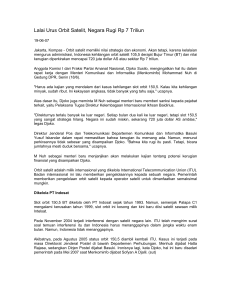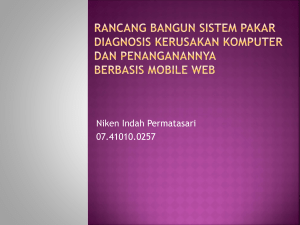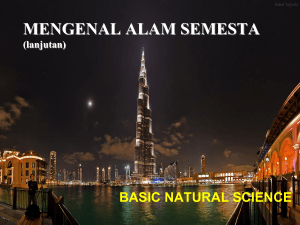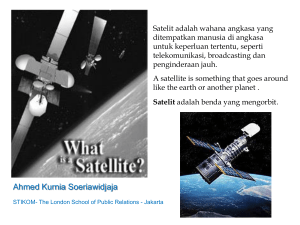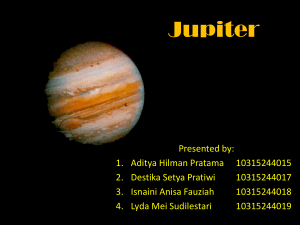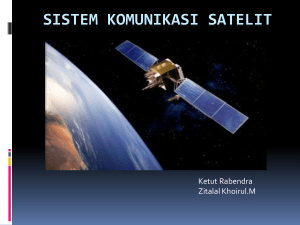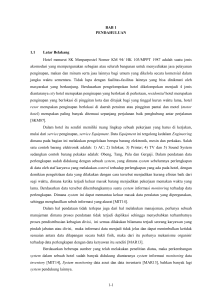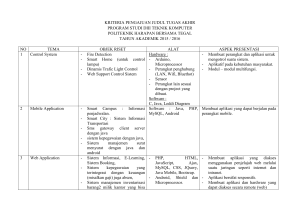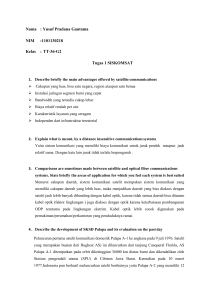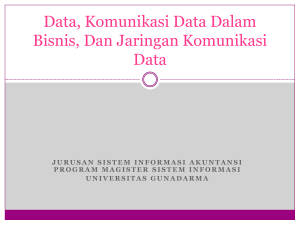Satellite based system
advertisement
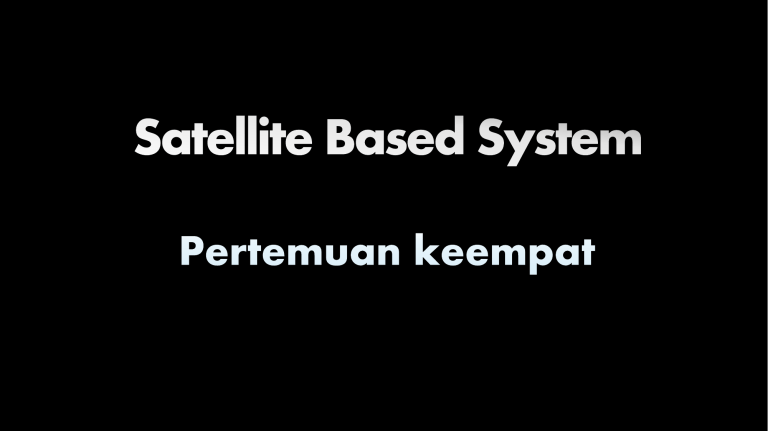
Apa itu satellite? Satelit adalah benda yang mengorbit benda lain dengan periode revolusi dan rotasi tertentu. Satelit ada 2 tipe yaitu aktif dan pasif : Satelit aktif memiliki kemampuan untuk menerima dan mengirimkan kembali sinyal yang di dapat ke bumi. Satelit pasif hanya berfungsi sebagai pemantul saja. Satelit Komunikasi ?? Satelit komunikasi adalah sebuah satelit buatan yang ditempatkan di angkasa dengan tujuan telekomunikasi menggunakan radio pada frekuensi gelombang mikro. Satelit komunikasi di desain untuk menerima sinyal dari stasiun pengirim di bumi dan mengirimkannya ke stasiun penerima yang terletak dimana pun. Kebanyakan satelit komunikasi menggunakan orbit geosinkron atau orbit geostasioner, meskipun beberapa tipe terbaru menggunakan satelit pengorbit Bumi rendah Definisi Satelit ?? Satelit merupakan alat elektronik yang mengorbit di bumi dan mampu bertahan sendiri. Dapat diartikan sebagai repeater yang berfungsi untuk menerima signal gelombang microwave dari stasiun bumi, ditranslasikan frekuensinya, kemuadian diperkuat untuk dipancarkan kembali ke arah bumi sesuai dengan coverage-nya yang merupakan lokasi stasiun bumi tujuan atau penerima. Sistem Komunikasi Satelit 2 bagian penting yaitu space segment (bagian yang berada diangkasa) dan ground segment (biasa disebut stasiun bumi). Transponder Sebuah stasiun bumi memancarkan informasi ke satelit. Satelit ini berisi penerima yang mengambil sinyal yang ditransmisikan, menguatkan, dan menerjemahkannya pada frekuensi lain. Sinyal pada frekuensi baru kemudian dipancarkan kembali ke stasiun penerima di bumi kembali. Kombinasi pemancar-penerima di satelit dikenal sebagai transponder. Satellite Systems Komponen Dasar Link Satelit Classification Cakupan wilayah: Global, regional, nasional Jenis layanan: Fixed service satellite (FSS) = Layanan Satelit u/ radio Broadcast service satellite (BSS) = Layanan satelit u/ TV Mobile service satellite (MSS) = Layanan satelit u/ handphone Umum penggunaan Komersial, militer, amatir, eksperimental Orbits Orbit Satelit : Orbit Satelit Khatulistiwa Orbit Satelit memiliki kecenderungan miring Oorbit Satelit Kutub Tapak Satelit adalah sinyal satelit dari satu satelit memiliki area sinyal dan orbit tertentu Categories Satellite categories GEO (Geosynchronous Earth Orbit) MEO (Medium-Earth Orbit) LEO (Low-earth orbit) Keunggulan Komunikasi Satelit Cakupan yang luas: satu Negara, region, ataupun satu benua Bandwidth yang tersedia cukup lebar Independen dari infrastruktur terrestrial Layanan mobile/wireless yang independen terhadap lokasi Kelemahan Komunikasi Satelit Delay propagasi besar Rentan terhadap pengaruh atmosfer Biaya komunikasi untuk jarak pendek maupun jauh relative sama Hanya ekonomis jika jumlah user besar dan kapasitas digunakan secara intensif Sample system Mobile Communication and Mobile Computing Basics (1) • satellites describe elliptical or circular orbit around the earth • distance to the earth remains constant: FG m g R / r 2 m r FZ (1) 2 FG - Appeal of the Earth FZ - Centrifugal force m - Mass of the satellite R - Earth radius, 6.370km - Distance of the satellite to the Earth’s center r g ω f - Grounding acceleration, g = 9,81 m/s2 - Angular frequency: 2 f , T 1 / f 2 / - Cycle frequency of the satellite 16 Mobile Communication and Mobile Computing Satellite system classes GEO (Geostationary Earth Orbit) ca. 36 000 km MEO (Medium Earth Orbit) ca. 6000 - 12 000 km HEO (Highly Elliptical Orbit) LEO (Low Earth Orbit) ca. 500 - 1500 km Van-Allen-belts 2000 - 6000 km 15 000 - 30 000 km (no satellite use possible) 17 Mobile Communication and Mobile Computing Elevation 19 Mobile Communication and Mobile Computing Geostationary Satellite systems Principle: Satellit Base for Inmarsat Uplink • • • • Downlink Constant position to the Earth, 3 satellites cover complete earth (with the exception of the polar caps), satellites move synchronously to the Earth Simple solution, however large distance (36000 km), therefore high signal propagation delay, long life time of the satellites: ~ 15 years low data rates, large transmission power required problems: – on the other side of the 60th degree of latitude reception problems (elevation) – because of a high transmission power unfavorable for mobile telephones – signal propagation delay too high (0.25 s) 20 Mobile Communication and Mobile Computing 21 KONSTELASI SATELIT Untuk cakupan global biasanya dibutuhkan banyak satelit yang ditempatkan dalam beberapa bidang orbit, dan spasi antar satelit ditentukan Mobile Communication and Mobile Computing 23 Mobile Communication and Mobile Computing LEO- Systems • non-stationary satellites (LEO - Low Earth Orbit) • distance to the earth ~ 500 - 2000 km • shorter signal runtimes (5-10 ms), lower transmission power of the mobile stations sufficing • however more satellites necessary, frequent handover between satellites, approximately all 10 min. • examples: Teledesic, Globalstar • only low transmission power necessary, suitable for mobile phone networks • Disadvantages: – large number is necessary (50 - 200, or more) – fast handovers within satellites are necessary – short life time of the satellites because of atmospheric friction (5-8 years) 24 Mobile Communication and Mobile Computing MEO- Systems • ~ 10000km, lower number of satellites necessary : ~12 • slow movement: handover between satellites is hardly necessary • cycle duration: 6h • high elevation enables coverage large, highly-populated areas • Problems: – signal propagation delay: 70 to 80 ms – higher transmission power is necessary – special antennas for small cells are necessary 25 Mobile Communication and Mobile Computing MEO- Systems • ~ 10000km, lower number of satellites necessary : ~12 • slow movement: handover between satellites is hardly necessary • cycle duration: 6h • high elevation enables coverage large, highly-populated areas • Problems: – signal propagation delay: 70 to 80 ms – higher transmission power is necessary – special antennas for small cells are necessary 26 Mobile Communication and Mobile Computing Examples of satellite-based systems Satellites Height Data rate Teledesic (planned) 288 (?) ~ 700 km 64 Mbit/s 2 / 64 Mbit/s Iridium 66 (+6) ~ 780 km 2,4 / 4,8 kbit/s Globalstar 48 (+4) ~ 1400 km 9,6 kbit/s ICO 10 (+2) ~ 10 000 km 4,8 kbit/s Inmarsat 5 geostationary 2,4 kbit/s Orbcomm 35 LEO-stationary 57,6 kbit/s Globalstar can transfer bi-directionally up to 144 Kbit/s, through combination of channels Orbcomm - first commercial LEO–service worldwide http://Globalstar.com/ 27 Mobile Communication and Mobile Computing Comparison of satellite-based systems Satellite-based system GEO MEO LEO Distance, km r = 35.786 km r-R=6000 – 12000 km r-R= 500 – 2000 km Cycle duration, T 24 h 6h 95 – 120 min Signal propagation delay, t 0.25 s 70-80 ms 10 ms Transmission power, W 10 5 1 Use examples Numerous systems, approx. 2000: •Sputnik (1957) •Intelsat 1-3 (1965, 1967, 1969) •Marisat (1976) •Inmarsat-A (1982) •Inmarsat-C (1988) ICO 10+2 •Iridium (bankrupt, 2000) 66+6 •Globalstar, 48+4/ 144 kBit/s •Teledesic (2003), 288/ 2-64 MBit/s • Orbcomm, 35 Data rate, kBit/s 0.1 – 1 10 1 – 64000 Life time, years 15 10 5-8 28 Alokasi Spektrum Any Questions
